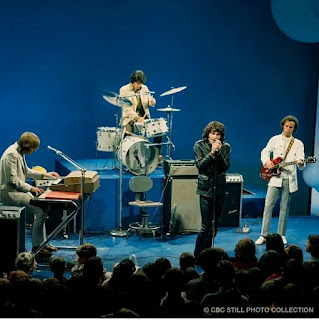THE DOORS’ “L’AMERICA”: AN AMERICAN EPIC SET TO MUSIC
In 1969, The Doors still lacked a soundtrack for an innovative film made
by a famous and respected director.
That autumn, the band began recording their fifth LP, Morrison Hotel.
Around this time, Michelangelo Antonioni approached the band to ask if
they had any tune that could be used in the soundtrack for his next film.
For Zabriskie Point, Antonioni's film due for release the following
year, The Doors composed an unusual-sounding rock song: "L'America".
However, the famous director rejected their idea and turned to Pink
Floyd and other artists instead. Consequently, “L’America” remained unused until
it was included on the group's sixth album, "L.A. Woman" about a year
later.
The structure of this track is built around the repetition of a simple, somber
main riff played on Robby Krieger's fuzz-distorted electric guitar, which is
constantly picked up by the electric bass.
This combination drives the main part of the song, deliberately creating
an atmosphere charged with dark eeriness and mysterious tension.
Supporting this repeated guitar riff, which is played with low, solemn
and grave notes, are two additional sonic elements.
The first is another electric guitar line developed by Krieger in
synergy with the main riff, and similar to it. This line is particularly
prominent in the final section of 'L'America', serving to make the sound of the
first guitar even more pervasive and wide-reaching.
The second element is Ray Manzarek's electric organ (a Gibson G-101 in
this case). Its sound is noticeably distorted to establish a mysterious,
dreamlike ambience beneath the aforementioned guitar riff.
In this original sound context, verse and chorus alternate. In the
latter, Morrison simply repeats the song title insistently. Then, at min. 2:08,
a colorful middle section bursts in.
This portion of the composition takes up a third of the composition and
consists of three distinct phases.
The first phase (from min. 2:08 to min. 2:29) is an unexpected leap into
rock-blues, made all the more exciting by Morrison's voice. Musically, it is
led by Manzarek's electric organ, which is now played without any distortion.
The second phase (from min. 2.30 to min. 2.53) sees a return to the
eerie atmosphere that dominates the tune, with a solo shared between the
electric organ and electric guitar. Meanwhile, the dark main riff returns and
remains in the background.
The third phase (from min. 2.54 to min. 3.30) features a nonchalant
motif sung by Morrison which is abruptly interrupted by some desolate and
enigmatic verses, preparing the listener for the return of the gloomy main
guitar theme and final verse-chorus.
The musical passages that alternate throughout the song, together with
their lyrics, offer a quick overview of the Latin American epic.
They depict the arrival of the Europeans, ready to deceive the natives
in order to obtain their gold, and the social changes that led to the formation
of a new shared identity between the indigenous people and the colonizers.
Alongside Jim Morrison's lyrics, another point about this composition is
worth clarifying.
The version of the tune that appears on the “L.A. Woman” album is almost
certainly the one that The Doors prepared for the film “Zabriskie Point” in the
second half of 1969. Therefore, it was not re-recorded for the “L.A. Woman” LP.
This rules out the possibility that the bass player was Jerry Scheff,
the session musician who played the electric bass on L.A. Woman, and suggests
two other solutions.
The first is that it was either Ray Neopolitan or Lonnie Mack, who were
both in the studio for the "Morrison Hotel" sessions when
"L'America" was recorded in the last months of 1969.
However, Mack's occasional presence in the recording studio and
Neopolitan's noticeably different style tend to disprove this theory.
The second solution is that Robby Krieger played the bass himself, as he
had occasionally done in the past in the recording studio, in addition to
playing the electric guitar.
As mentioned at the beginning of this article, the bass line follows
that of the electric guitar, making it more likely that Krieger played the bass
on "L’America".
With its socio-historical references and predominantly dark arrangement,
the song we have analyzed briefly is one of The Doors' least accessible
creations.
This is mainly due to its original purpose: to be the soundtrack of a
film about the emerging social protest movement in the USA in the 1960s and
1970s.
Additionally, the band found this niche film soundtrack setting a
propitious opportunity to experiment with more daring sonic ingredients that
were less suited to the tastes of the general public.
P.S.: My book "The Doors Through Strange Days"- The most comprehensive journey ever made through The Doors' second LP, is available on Amazon.com, .uk, .mx, .it, etc.
Here’s a link:
Amazon – “The Doors Through Strange Days”




Comments
Post a Comment